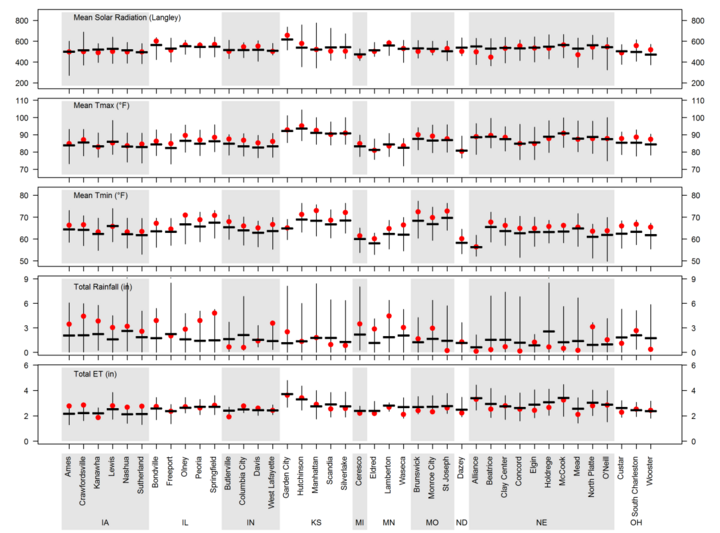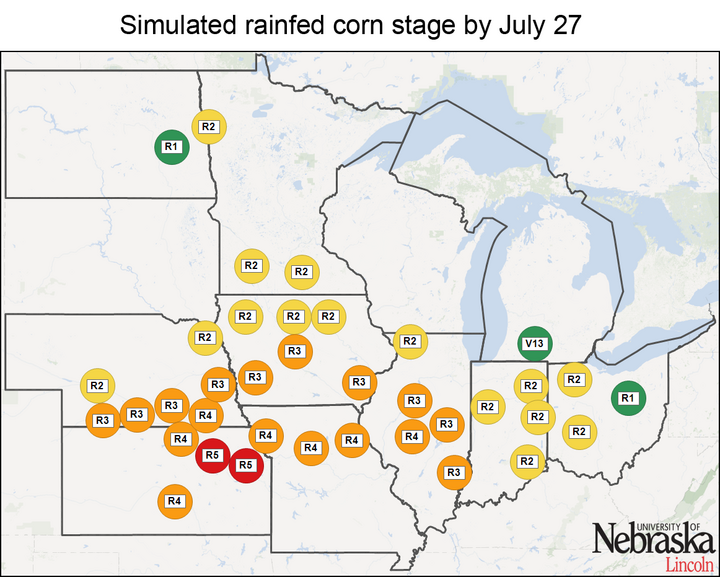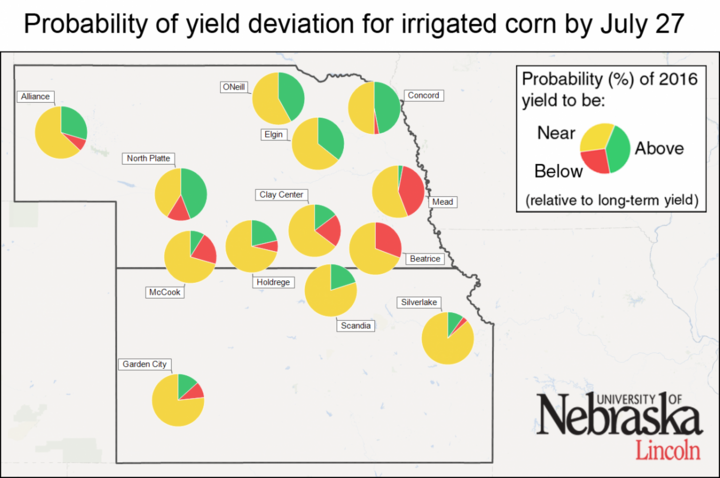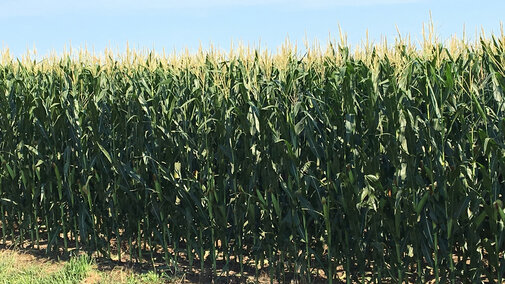To evaluate, in “real-time,” the impact of this season’s weather on corn yield potential and its spatial variability across the Corn Belt, simulations of 2016 end-of-season corn yield potential and real-time crop stage were performed for 41 locations. The simulations were developed using the UNL Hybrid-Maize model in collaboration with faculty and extension educators from 10 universities. This is the second article in a series summarizing simulated crop stages and yield forecasts for a wide area of the Corn Belt.
Data for the July 27 corn yield forecasts can be downloaded. Previous corn yield forecasts for this year can be found here. Details on Hybrid-Maize and the underpinning methodology to forecast end-of-season yields, as well as on interpretation and uses of yield forecasts, is described in a previous article.
The season continued with high temperatures (especially nighttime temperatures) during the second half of July. Rainfall was highly variables across locations, with above-normal rainfall in Iowa, Illinois, and Minnesota, but below-normal rainfall in Nebraska. A summary of weather conditions during the last two weeks is shown in Figure 1.

Figure 1. Daily solar radiation, maximum and minimum air temperature (Tmax and Tmin), total rainfall, and total reference grass-based evapotranspiration (ET) for the July 13-July 27, 2016 period. Vertical bars indicate the range for these variables based on 20+ years of weather records. The horizontal thick line indicates the long-term average and the red dots indicate 2016 values.
Simulated Corn Stage Across 41 Locations
Corn throughout most of the Corn Belt is at the early stages of grain filling (blister, milk, and dough stages), except for corn in the southern states (Kansas and Missouri), which is running ahead of the rest of the region (Figure 2).

Figure 2. Simulated crop stage for irrigated and rainfed corn at each location. Vn: vegetative stage (nth leaf); R1: silking; R2: blister; R3: milk; R4: dough; R5: dent. Separate maps are shown for irrigated and rainfed corn.

Irrigated Corn: Low Probability of Below-Average Yield Persists
The range of forecasted irrigated corn yields for each location, as well as the probabilities for yields above, near or below average, are shown in Figures 3 and 4. There is a high probability (>75%) of near-average yields at all irrigated sites in Kansas. While it is too early in the growing season to tell if forecasted irrigated yields for Nebraska will remain near or above long-term average yields, the probability of below-average yield continues to be low (e.g., high temperature) prevail during the rest of the growing season.

Figure 4. Probability of obtaining a 2016 yield below (≤10%, red color), near (±10%, yellow color), and above (>10%, green color) the long-term (2005-2014) average at each location. Separate maps are shown for irrigated corn (top) and rainfed corn (bottom). The larger a color section is within the pie chart, the higher the probability that corn yield will be in that category.

Rainfed Corn: Highly Uncertain and Variable Yields Across Locations
For rainfed corn, the range of forecasted yields is still wide and looks highly variable across locations (Figures 3 and 4). There is a relatively high probability (>75%) of above-average yield at five of the 37 rainfed locations: western Nebraska (North Platte), eastern North Dakota (Dazey), northern Minnesota (Eldred), northeastern Missouri (St Joseph), and central Illinois (Peoria). But there is a high chance (>75%) of below-average yield in southeastern Nebraska (Beatrice) and southeastern Iowa (Crawfordsville).
Similarly, the yield scenarios do not look promising for three other sites in Nebraska (McCook, Clay Center, and Concord) and one site in Iowa (Ames). Forecasted yields at these sites may improve if weather conditions are favorable the rest of the season. Finally, there is a high probability (>75%) of near-average yield at seven locations, located mainly in the southern fringe of the Corn Belt. The yield scenario remains highly uncertain for the other 19 rainfed sites.
Conclusions
In general, there has not been too much change since the corn yield forecasts we released on July 13. Growing conditions up to now indicate low probability of below-average yields at most irrigated sites, except for southeastern Nebraska where there is a 30-40% chance of below-average yields if unfavorable weather conditions (e.g., high temperature) prevail during the rest of the season.
End-of-season rainfed yields are still highly uncertain for half of the rainfed sites. For the other half of the sites, forecasted rainfed yields fall into above, below or near-average categories across locations. These forecasts do not take into consideration problems with stand emergence, hail/flooding damage, replanting situations, disease, or nitrate leaching. Therefore, in fields negatively affected by these constraints, actual yields will be lower than the estimates provided here.
It is important to keep in mind that yield forecasts are not field specific and, instead, represent an estimate of average on-farm yield for a given location and surrounding area in absence of the yield-reducing factors mentioned here. Likewise, crop stages and forecasted yields will deviate from the ones reported here in fields with planting dates or hybrid maturities that differ markedly from the ones used as the basis for the forecasts. We will follow up with further forecasts in early August.
Contact
If you have questions regarding this forecast, contact Patricio Grassini, Extension Cropping System Specialist and Water for Food Institute Fellow, at pgrassini2@unl.edu, phone: 402-472-5554.

